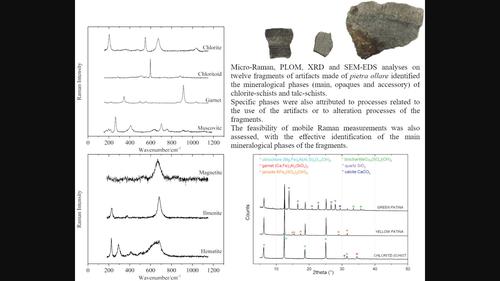当前位置:
X-MOL 学术
›
J. Raman Spectrosc.
›
论文详情
Our official English website, www.x-mol.net, welcomes your feedback! (Note: you will need to create a separate account there.)
Multi-analytical characterization of archaeological fragments of pietra ollare from the Medieval site ‘Piana di S. Martino’ (Piacenza, Italy): A mobile and laboratory approach
Journal of Raman Spectroscopy ( IF 2.5 ) Pub Date : 2023-12-22 , DOI: 10.1002/jrs.6638 Laura Fornasini 1 , Luciana Mantovani 2 , Michela Bertolini 3 , Roberta Conversi 3 , Danilo Bersani 1
Journal of Raman Spectroscopy ( IF 2.5 ) Pub Date : 2023-12-22 , DOI: 10.1002/jrs.6638 Laura Fornasini 1 , Luciana Mantovani 2 , Michela Bertolini 3 , Roberta Conversi 3 , Danilo Bersani 1
Affiliation

|
The archaeological excavations in the site of ‘Piana di San Martino’ (Pianello Val Tidone, Piacenza, Italy) discovered several fragments of pietra ollare (soapstone) artefacts, dating back to the Medieval period. A selection of fragments was characterized with micro-Raman spectroscopy in order to determine their composition, in terms of main and accessory species. The morphology of the crystals and the mineral phases were also investigated with polarized-light microscopy observations, X-ray powder diffraction and Scanning Electron Microscopy with Energy-Dispersive System analyses, which corroborate the Raman results. A detailed characterization was obtained on 12 fragments ascribable to pots and a millstone, made of talc-schists or chlorite-schists, including garnet-bearing chlorite-schists. Interest findings about the activities related to the use of these artefacts and the alteration processes occurred during their burial period were highlighted by the identification of specific products. Additionally, mobile Raman measurements were performed on the fragments, and a quick and effective evaluation of their composition was successfully achieved. These results highlight the use of mobile Raman instruments in the field of archaeology, specifically referred to pietra ollare findings, for which a preliminary identification may be obtained directly in situ.
中文翻译:

对中世纪遗址“Piana di S. Martino”(意大利皮亚琴察)的 petra ollare 考古碎片进行多分析表征:一种移动和实验室方法
在“Piana di San Martino”(意大利皮亚琴察皮亚内洛瓦尔蒂多内)遗址的考古发掘中,发现了几块可追溯到中世纪时期的皂石(pietra ollare )文物碎片。使用显微拉曼光谱对选定的碎片进行表征,以确定其主要和辅助物种的组成。还通过偏光显微镜观察、X 射线粉末衍射和扫描电子显微镜与能量色散系统分析研究了晶体和矿物相的形态,这证实了拉曼结果。对 12 个由滑石片岩或绿泥石片岩(包括含石榴石的绿泥石片岩)制成的罐子和磨石碎片进行了详细的表征。通过对特定产品的识别,突出了与这些文物的使用相关的活动以及其埋葬期间发生的改变过程的兴趣发现。此外,还对碎片进行了移动拉曼测量,并成功地对其成分进行了快速有效的评估。这些结果强调了移动拉曼仪器在考古领域的使用,特别是指pietra ollare的发现,可以直接在现场进行初步鉴定。
更新日期:2023-12-22
中文翻译:

对中世纪遗址“Piana di S. Martino”(意大利皮亚琴察)的 petra ollare 考古碎片进行多分析表征:一种移动和实验室方法
在“Piana di San Martino”(意大利皮亚琴察皮亚内洛瓦尔蒂多内)遗址的考古发掘中,发现了几块可追溯到中世纪时期的皂石(pietra ollare )文物碎片。使用显微拉曼光谱对选定的碎片进行表征,以确定其主要和辅助物种的组成。还通过偏光显微镜观察、X 射线粉末衍射和扫描电子显微镜与能量色散系统分析研究了晶体和矿物相的形态,这证实了拉曼结果。对 12 个由滑石片岩或绿泥石片岩(包括含石榴石的绿泥石片岩)制成的罐子和磨石碎片进行了详细的表征。通过对特定产品的识别,突出了与这些文物的使用相关的活动以及其埋葬期间发生的改变过程的兴趣发现。此外,还对碎片进行了移动拉曼测量,并成功地对其成分进行了快速有效的评估。这些结果强调了移动拉曼仪器在考古领域的使用,特别是指pietra ollare的发现,可以直接在现场进行初步鉴定。



























 京公网安备 11010802027423号
京公网安备 11010802027423号